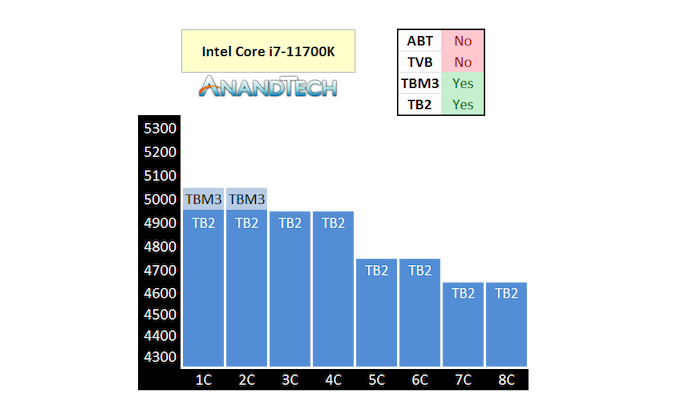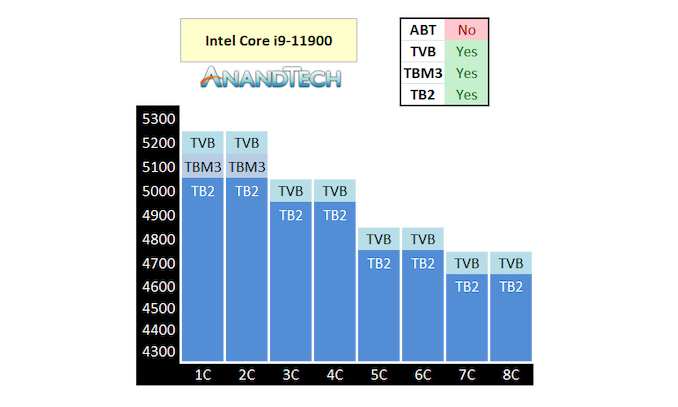Intel Rocket Lake (14nm) Review: Core i9-11900K, Core i7-11700K, and Core i5-11600K
by Dr. Ian Cutress on March 30, 2021 10:03 AM EST- Posted in
- CPUs
- Intel
- LGA1200
- 11th Gen
- Rocket Lake
- Z590
- B560
- Core i9-11900K
Intel’s New Adaptive Boost Technology for Core i9-K/KF
Taken from our news item
To say that Intel’s turbo levels are complicated to understand is somewhat of an understatement. Trying to teach the difference between the turbo levels to those new to measuring processor performance is an art form in of itself. But here’s our handy guide, taken from our article on the subject.
Adaptive Boost Technology is now the fifth frequency metric Intel uses on its high-end enthusiast grade processors, and another element in Intel’s ever complex ‘Turbo’ family of features. Here’s the list, in case we forget one:
| Intel Frequency Levels | ||
| Base Frequency | - | The frequency at which the processor is guaranteed to run under warranty conditions with a power consumption no higher than the TDP rating of the processor. |
| Turbo Boost 2.0 | TB2 | When in a turbo mode, this is the defined frequency the cores will run at. TB2 varies with how many cores are being used. |
| Turbo Boost Max 3.0 | TBM3 'Favored Core' |
When in a turbo mode, for the best cores on the processor (usually one or two), these will get extra frequency when they are the only cores in use. |
| Thermally Velocity Boost | TVB | When in a turbo mode, if the peak thermal temperature detected on the processor is below a given value (70ºC on desktops), then the whole processor will get a frequency boost of +100 MHz. This follows the TB2 frequency tables depending on core loading. |
| Adaptive Boost Technology | ABT 'floating turbo' |
When in a turbo mode, if 3 or more cores are active, the processor will attempt to provide the best frequency within the power budget, regardless of the TB2 frequency table. The limit of this frequency is given by TB2 in 2-core mode. ABT overrides TVB when 3 or more cores are active. |
| *Turbo mode is limited by the turbo power level (PL2) and timing (Tau) of the system. Intel offers recommended guidelines for this, but those guidelines can be overridden (and are routinely ignored) by motherboard manufacturers. Most gaming motherboards will implement an effective ‘infinite’ turbo mode. In this mode, the peak power observed will be the PL2 value. It is worth noting that the 70ºC requirement for TVB is also often ignored, and TVB will be applied whatever the temperature. | ||
Intel provided a slide trying to describe the new ABT, however the diagram is a bit of a mess and doesn’t explain it that well. Here’s the handy AnandTech version.
First up is the Core i7-11700K that AnandTech has already reviewed. This processor has TB2, TBM3, but not TVB or ABT.
The official specifications show that when one to four cores are loaded, when in turbo mode, it will boost to 4.9 GHz. If it is under two cores, the OS will shift the threads onto the favored cores and Turbo Boost Max 3.0 will kick in for 5.0 GHz. More than four core loading will be distributed as above.
On the Core i9-11900, the non-overclocking version, we also get Thermal Velocity Boost which adds another +100 MHz onto every core max turbo, but only if the processor is below 70ºC.
We can see here that the first two cores get both TBM3 (favored core) as well as TVB, which makes those two cores give a bigger jump. In this case, if all eight cores are loaded, the turbo is 4.6 GHz, unless the CPU is under 70ºC, then we get an all-core turbo of 4.7 GHz.
Now move up to the Core i9-11900K or Core i9-11900KF, which are the only two processors with the new floating turbo / Adaptive Boost Technology. Everything beyond two cores changes and TVB no longer applies.
Here we see what looks like a 5.1 GHz all-core turbo, from three cores to eight cores loaded. This is +300 MHz above TVB when all eight cores are loaded. But the reason why I’m calling this a floating turbo is because it is opportunistic.
What this means is that, if all 8 cores are loaded, TB2 means that it will run at 4.7 GHz. If there is power budget and thermal budget, it will attempt 4.8 GHz. If there is more power budget and thermal budget available, it will go to 4.9 GHz, then 5.0 GHz, then 5.1 GHz. The frequency will float as long as it has enough of those budgets to play with, and it will increase/decrease as necessary. This is important as different instructions cause different amounts of power draw and such.
If this sounds familiar, you are not wrong. AMD does the same thing, and they call it Precision Boost 2, and it was introduced in April 2018 with Zen+. AMD applies its floating turbo to all of its processors – Intel is currently limiting floating turbo to only the Core i9-K and Core i9-KF in Core 11th Gen Rocket Lake.
One of the things that we noticed with AMD however is that this floating turbo does increase power draw, especially with AVX/AVX2 workloads. Intel is likely going to see similar increases in power draw. What might be a small saving grace here is that Intel’s frequency jumps are still limited to full 100 MHz steps, whereas AMD can do it on the 25 MHz boundary. This means that Intel has to manage larger steps, and will likely only cross that boundary if it knows it can be maintained for a fixed amount of time. It will be interesting to see if Intel gives the user the ability to change those entry/exit points for Adaptive Boost Technology.
There will be some users who are already familiar with Multi-Core Enhancement / Multi-Core Turbo. This is a feature from some motherboard vendors have, and often enable at default, which lets a processor reach an all-core turbo equal to the single core turbo. That is somewhat similar to ABT, but that was more of a fixed frequency, whereas ABT is a floating turbo design. That being said, some motherboard vendors might still have Multi-Core Enhancement as part of their design anyway, bypassing ABT.
Overall, it’s a performance plus. It makes sense for the users that can also manage the thermals. AMD caught a wind with the feature when it moved to TSMC’s 7nm. I have a feeling that Intel will have to shift to a new manufacturing node to get the best out of ABT, and then we might see the feature on the more mainstream CPUs, as well as becoming default as standard.













279 Comments
View All Comments
Qasar - Tuesday, March 30, 2021 - link
nope zen 3, they are waiting for the ryzen 5000 series to be in stock, and once they do, they will upgrade, some were looking at 5600X or 5800X, but now, might move up a tier vs what they would of picked up if they were in stock from day one.Tomatotech - Tuesday, March 30, 2021 - link
Is there a problem with your keyboard? It doesn’t seem able to type the word ‘shit’ properly. Seems a common problem with American keyboards.Holliday75 - Tuesday, March 30, 2021 - link
I have an American keyboard.Shit.
Works for me.
ImSteevin - Tuesday, March 30, 2021 - link
AMD got used to fighting hard with reduced resources and Intel got used to being comfy at the top. Bought AMD at $13, always believed in the real MVP.SaturnusDK - Wednesday, March 31, 2021 - link
I bought AMD shares when they hit the $2 mark. I usually do that when any tech stock hits $2 and I have some spare cash, and then keep it for a minimum of a year. In 2016 it was AMD .Last year it was Kodak.JayNor - Tuesday, March 30, 2021 - link
"AMD is the top dog and intel cannot even catch up...."Intel is already sampling 16 core 24 thread Alder Lake chips ... pcie5, ddr5, new cores. They showed a desktop running it at CES. When will AMD catch up with these features?
SkyBill40 - Tuesday, March 30, 2021 - link
Intel couldn't get 10nm on desktop, yet we're supposed to believe that they're suddenly going to pull a magic rabbit out of a hat tomorrow? Hardly. By the time Intel gets around to having a worthwhile process on something other than 14nm, AMD will be on 5nm. They're almost there as is.16/24? Why bother with that when AMD has 16/32 NOW? While it may not have PCI-E5 or DDR5, it doesn't need it but will likely have it soon enough. AMD catch up? Come on, man. AMD is in FRONT and has been for a while now. It's all about Intel getting it together and trying to close the gap they themselves created due to complacency, mismanagement, and underestimating their opponent.
Qasar - Tuesday, March 30, 2021 - link
jaynor, i think that will be Zen 4, for the most part, its intel that has caught up to AMD with its features. and um if you haven't noticed even with a release bios, microcode etc, looks like rocket lake is still the dud AT shows it was turning out to be a couple of weeks ago.Hifihedgehog - Tuesday, March 30, 2021 - link
> Intel is already sampling 16 core 24 threadLOL. 16 cores and 32 threads of full fat Zen cores is ALWAYS better than 8 cores and 16 threads of full fat Core cores and 8 cores and 8 threads of garbage tier Atom cores.
flgt - Tuesday, March 30, 2021 - link
Yeah, that seems like a mobile first design which will be “good enough” for corporate desktops. Seems like Intel is giving up on the desktop enthusiast market.